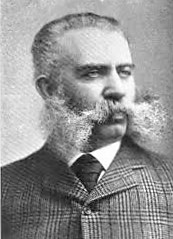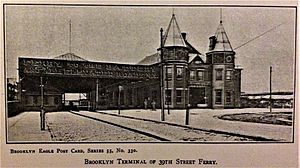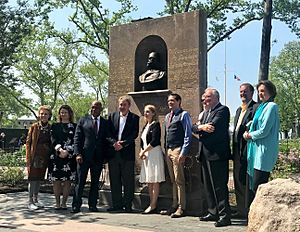John Wolfe Ambrose facts for kids
Quick facts for kids
John Wolfe Ambrose
|
|
|---|---|

John Wolfe Ambrose, c. 1880s.
|
|
| Born | 10 January 1838 Newcastle West |
| Died | 15 May 1899 (aged 61) |
| Resting place | Green-Wood Cemetery |
| Occupation | Civil engineer |
John Wolfe Ambrose (born January 10, 1838 – died May 15, 1899) was an Irish-American engineer and builder. He is famous for helping to create important shipping paths in and around New York Harbor. His work made sure that New York stayed a major center for world trade and shipping. He also helped improve the city's cleaning systems, roads, and train lines.
Contents
Early Life in Ireland and America
John Wolfe Ambrose was born in Newcastle West, Ireland. When he was 13, on August 22, 1851, he traveled from Queenstown, Ireland. He sailed on the ship New York to New York City. His mother, Bridget Wolfe Ambrose, and his brothers and sisters came with him. His father, John Ambrose, had already arrived in New York City in May 1851. John Wolfe Ambrose's older brother, James, came to America on his own. He later became a respected police officer in Staten Island, New York.
Education and Early Career
Ambrose first studied at the Princeton Theological School. Today, this school is known as Princeton University. He planned to become a minister. However, after only one year, he left. He then went to the University of the City of New York, which is now New York University. This school helped him become a top civil engineer.
People said he was very smart. He studied a lot of math. He could also speak four languages: English, Irish, Latin, and Greek. After graduating in 1860, he chose to work as a newspaper reporter. He wrote for the Citizens' Reform Association.
Building New York City
Soon after, Ambrose started working with John Brown, a well-known contractor. Brown was in charge of cleaning the city's streets. Ambrose learned a lot about the Street Cleaning Department from Brown. Later, when Mayor Hugh J. Grant wanted to improve the department, Ambrose created a new plan. The city liked his plan and used it.
His plan divided the city into smaller areas. It used street cleaners in uniforms. They used hand carts to remove garbage from the streets. This experience made Ambrose very interested in making New York City better.
Major Construction Projects
Ambrose started his own building business. He completed many big projects. He built the entire Second Avenue elevated railroad. This train line went from the Harlem River to Chatham Square. He also built part of the West Side elevated railroad. This section was between 75th and 189th Streets.
He also laid the first eight miles (13 km) of pneumatic tubes in the United States. These tubes went under New York streets for the Western Union Telegraph Company. He also built gas factories and laid ninety miles of gas pipes for the Knickerbocker Gas Company. From 1873 to 1880, he built many streets in Manhattan's uptown area. He turned swamp land in Harlem into city streets.
Developing Brooklyn's Waterfront
In 1880, Ambrose became interested in developing the waterfront areas of Brooklyn. His biggest dream was a huge plan to improve New York. He started the South Brooklyn Railroad & Terminal Company. He also created the 39th Street South Brooklyn Ferry and the Brooklyn Wharf & Dry Dock Company. He was the president of all these companies.
Ambrose wanted Battery to be New York's main entry point. He hoped to bring all of Long Island's train traffic there. He planned to do this using his terminal railroad and ferry companies. Ambrose also dreamed of building six huge steamship piers. These piers would be very long, from 900 to 2,200 feet (274 to 671 m). He wanted to attract large ocean liners to Brooklyn. Each pier would have two train tracks between large warehouses. There would also be a 5-acre (20,000 m²) storage yard. His full plan never came true. However, because of his work on the Brooklyn waterfront, large areas of farmland became busy city neighborhoods.
Improving New York Harbor
Because of his big plans, Ambrose went to Washington, D.C., in 1881. He wanted to convince Congress to give money. This money would be used to dig out the inner channels of New York Harbor. He also wanted to make the Sandy Hook Bar deeper. Over the next fifteen years, Ambrose successfully got $1,478,000 from Congress. This money was used to improve the Bay Ridge and Red Hook channels.
In 1898, after improving the inner harbor, Ambrose started pushing for more money. He asked the House of Representatives' Rivers and Harbors Committee for funds. He wanted to build a proper channel starting at Sandy Hook, New Jersey, and leading into New York Harbor. The committee said no to his plan. But in the spring of 1899, just before he died, the Senate's Commerce Committee approved $6,000,000 for the project. This new channel made the shipping route shorter and safer. It was especially helpful for the largest ships.
Family Life
John Wolfe Ambrose married Katharine (Kate) Weeden Jacobs on July 1, 1860. They had five children: Katharine (Kate) Wolfe Shrady, John Fremont, Ida Virginia, Thomas Jefferson, and Mary. Only his daughter Kate and son John got married. Only John had children with his wife, Minnie Shrady. The family lived in a townhouse at 575 Lexington Avenue. Both John and Kate died there. The whole family is buried together at Green-wood Cemetery in Brooklyn, New York.
Legacy and the Ambrose Channel
Ambrose died on May 15, 1899, from typhoid fever. He never saw the new channel finished, which happened in 1907. The Lusitania was the first ship to use the channel in September 1907. But to honor his hard work, the New York State Legislature thanked Ambrose in 1900. They named the channel and its lightship after him.
Today, the Ambrose Channel is still the main way ocean ships enter New York Harbor. The Lightship Ambrose is a registered National Historic Landmark. You can visit it at Lower Manhattan's South Street Seaport Museum.
On June 3, 1936, a memorial statue of Ambrose was put up in his honor. His daughter, Katharine Wolfe Ambrose Shrady, and Mayor Fiorello La Guardia unveiled it at Battery Park. Mayor La Guardia called Ambrose "the pioneer of an idea." He said Ambrose "was a man ahead of his time. He had vision and persistence to...continually press...his idea."
Sadly, in November 1990, the statue was stolen and never found. But in late 2017, the City Parks Department made a new statue. They restored the monument, making it even more beautiful. On May 15, 2018, the anniversary of Ambrose's death, the city held a special ceremony. About 100 people attended, including many of Ambrose's family members from different states and Ireland. The new monument is now located at The Battery, between Pearl and Water Streets.




